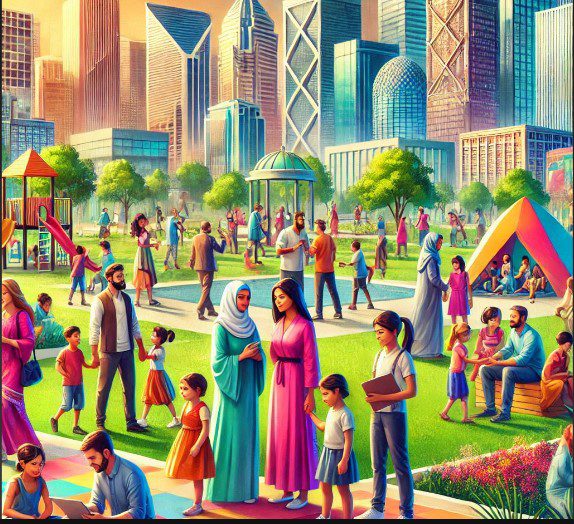Urbanization, the process by which rural areas transform into urban centers, significantly impacts family structures and dynamics. As people migrate to cities in search of better economic opportunities, education, and healthcare, traditional family systems undergo profound changes. This transformation affects living arrangements, roles within the family, and intergenerational relationships. Below is a detailed analysis of how urbanization shapes family structures, with examples from global contexts and countries like Pakistan.
1. Shift from Joint to Nuclear Families
Urbanization often leads to a transition from extended or joint family systems to nuclear family arrangements.
Key Features:
- Limited Space in Urban Areas: Cities have higher population densities, making housing smaller and more expensive. This reduces the feasibility of joint family living.
- Economic Independence: Urban life often promotes individualism, where young couples prefer living independently from their parents.
Examples:
- In Pakistan, joint family systems are deeply rooted in rural areas, but urban centers like Karachi, Lahore, and Islamabad are witnessing a rise in nuclear families due to space constraints and changing lifestyles.
- Globally, cities like Tokyo and New York show a similar trend, where nuclear families dominate urban living arrangements.
Impact:
- Positive: Promotes autonomy and privacy for young couples.
- Negative: Reduces the support system traditionally provided by extended families, especially for elderly care.
2. Changing Gender Roles
Urbanization often brings about shifts in traditional gender roles within the family.
Key Features:
- Increased Workforce Participation: Women in urban areas have greater access to education and employment opportunities, altering traditional roles as homemakers.
- Shared Responsibilities: Dual-income households in cities often require men to participate in domestic chores and childcare.
Examples:
- In Pakistan, cities like Islamabad see a rise in working women, challenging traditional patriarchal family dynamics. Women contributing financially to the household often have a stronger voice in family decisions.
- In India, urbanization has led to an increase in women pursuing higher education and careers, though this sometimes creates conflicts with traditional expectations.
Impact:
- Positive: Empowers women and promotes gender equality.
- Negative: Can create tension between generations as older family members may struggle to accept changing gender norms.
3. Weakening of Intergenerational Bonds
Urbanization often reduces interaction and cohesion between generations.
Key Features:
- Physical Separation: As young individuals migrate to cities, they may leave behind elderly family members in rural areas.
- Generational Gaps: Urbanized youth often adopt modern lifestyles and values, which may conflict with traditional beliefs held by older generations.
Examples:
- In Pakistan, young professionals moving to cities for work or education often leave their parents behind in rural hometowns, leading to emotional and physical distancing.
- In countries like China, rapid urbanization has created a “left-behind” generation of elderly people in rural areas, dependent on sporadic financial support from their urbanized children.
Impact:
- Positive: Encourages independence and self-reliance among younger generations.
- Negative: Weakens family bonds and creates challenges in elder care and emotional support.
4. Influence on Marriage Patterns
Urbanization alters traditional practices related to marriage, including partner selection and family involvement.
Key Features:
- Delayed Marriages: Urban residents often delay marriage due to career aspirations and financial priorities.
- Choice of Partner: In cities, individuals are more likely to choose their partners, reducing the influence of arranged marriages.
- Smaller Families: Urban families tend to have fewer children due to economic constraints and lifestyle preferences.
Examples:
- In Pakistan, urban youth in cities like Lahore increasingly prefer love marriages or semi-arranged marriages, while rural areas still predominantly follow arranged marriage traditions.
- In Western countries, urbanization has normalized cohabitation before marriage, a practice less common in rural settings.
Impact:
- Positive: Provides individuals with greater autonomy and personal freedom.
- Negative: Can lead to conflicts with traditional family expectations and cultural norms.
5. Economic Pressures and Family Dynamics
Urban living often imposes financial pressures on families, reshaping their dynamics.
Key Features:
- Cost of Living: High expenses in urban areas force families to adopt frugal lifestyles or seek dual incomes.
- Work-Life Balance: Long working hours in cities may reduce the time family members spend together, leading to emotional detachment.
Examples:
- In Pakistan, the rising cost of living in cities like Karachi forces both spouses to work, which can strain family time and relationships.
- In metropolitan cities worldwide, the demand for long commutes and extended work hours often leaves parents with less time to spend with children.
Impact:
- Positive: Encourages efficient financial management and dual-income benefits.
- Negative: Reduces quality family time, potentially leading to feelings of neglect among children.
6. Changes in Parenting Styles
Urbanization influences parenting approaches, often moving away from traditional practices.
Key Features:
- Focus on Education: Urban parents prioritize their children’s education and extracurricular activities, seeing them as a path to upward mobility.
- Individualistic Values: Urban parents may emphasize independence and critical thinking over traditional obedience.
Examples:
- In Pakistan, urban parents are more likely to enroll their children in private schools, extracurricular programs, and tutoring services, compared to rural parents who may focus more on vocational skills.
- In urban Europe, parenting often involves greater emphasis on child autonomy and decision-making.
Impact:
- Positive: Prepares children for competitive urban environments.
- Negative: Creates pressures on children to excel, sometimes leading to mental health issues.
7. Increased Diversity in Family Forms
Urbanization contributes to the emergence of diverse family structures beyond the traditional models.
Key Features:
- Single-Parent Families: Higher divorce rates and changing societal norms in urban areas lead to an increase in single-parent households.
- Cohabitation: Unmarried couples living together is more accepted in urban areas than in rural settings.
- Same-Sex Couples: Urban centers are often more inclusive of LGBTQ+ families compared to rural areas.
Examples:
- In Pakistan, single-parent households are increasingly common in urban centers due to higher divorce rates. However, cohabitation and same-sex families remain less visible due to cultural conservatism.
- Globally, cities like New York and London are hubs for diverse family forms, reflecting greater social acceptance.
Impact:
- Positive: Expands the definition of family, promoting inclusivity.
- Negative: Challenges traditional norms, sometimes leading to social resistance.
8. Rise of Elderly Isolation
As younger generations migrate to cities, the elderly often face isolation and neglect.
Key Features:
- Left-Behind Elders: Older family members in rural areas may struggle with loneliness as their children move to urban centers.
- Elder Care Facilities: Urbanization has led to the growth of retirement homes, which are often seen as a last resort in traditional societies.
Examples:
- In Pakistan, the concept of retirement homes is gaining acceptance in cities like Lahore and Karachi, though it remains stigmatized in rural areas.
- In countries like Japan, urbanization has led to an aging population living alone, with the government promoting elder care services.
Impact:
- Positive: Encourages the development of elder care facilities and social support systems.
- Negative: Weakens traditional family bonds and the cultural value of filial piety.
Conclusion
Urbanization has profoundly reshaped family structures by transforming living arrangements, roles, and relationships. While it fosters independence, gender equality, and educational aspirations, it also creates challenges such as intergenerational gaps, elderly isolation, and weakened family bonds. Striking a balance between modern urban lifestyles and traditional family values is crucial to ensuring that the benefits of urbanization do not come at the expense of familial well-being and social cohesion. Countries like Pakistan, where family plays a central role in societal identity, must navigate these changes carefully to preserve both progress and tradition.
Stay tuned with Societyopedia to explore more about our social world.


